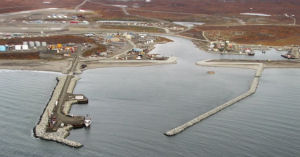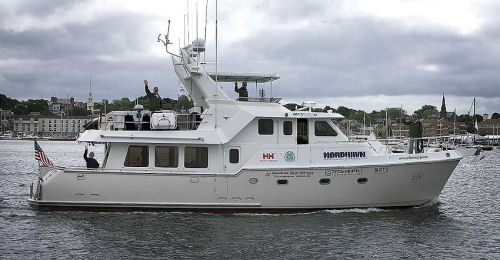107 Days from Newport
First in the early 1900s there was Roald Amundsen and it took him three winters in a sailboat with an inboard engine to transit the Northwest Passage. In 2005 a 57’ aluminum trawler, Idlewild, built
by a cattle rancher made it with some help from the Coast Guard. In 2007 the Northwest
Passage opened up due to global warming and the news got out and was spread around
the world. Last year a 46’ Lee Wilbur modified Downeast power cruiser made it from
Southwest Harbor, Maine. This year four cruise ships made their way to the passage,
and at least one made it through – twice, one passage east to west and once west
to east. Seven recreational boats attempted the passage and at least two that we
know of have made it – the Nordhavn 57 Bagan (above) and the 44’ Bavaria sailboat
Perithia being sailed by a German couple. The British Marines mentioned two weeks
ago made it as far as Gjoa Haven going west to east in their 17’ sailboat before
throwing in the towel.
The material published here has been excerpted -- and highly edited for reasons
of space -- from the blogs of Sprague Theobald as they appear on his website, www.northwestpassagefilm.com.
We urge you to visit the website and read the blogs in their entirety.
Read the 1st
installment of the saga...
Read the 2nd
installment of the saga...
Read the 3rd
installment of the saga...
Read the 4th
installment of the saga...
Read the 5th
installment of the saga...
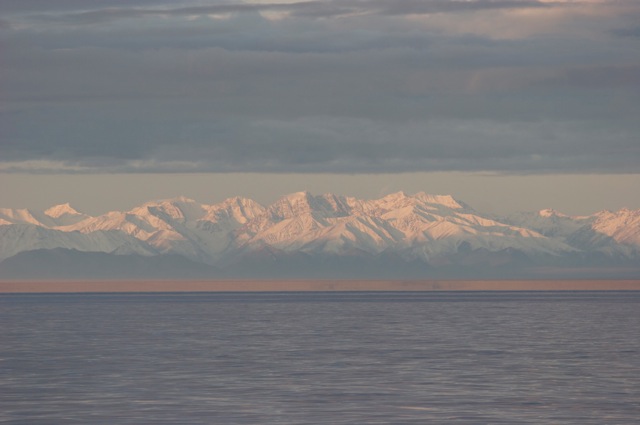 |
September 2nd – North Slope of Alaska
After spending a day in Tuktoyaktuk we left at 6:00 a.m. to start the trek to Barrow, AK. “Tuk” was a small village peopled with again, some of the friendliest and accommodating folks we’ve had a chance to meet on the trip. While the landscape was still fairly flat and rock-bound we did start to notice that the greenery was becoming more in evidence. Now there was actual color to be seen in the groundcover.
This morning when I came onto watch I was greeted by this view (see attached picture) off to our port. That’s the North Slope of Alaska. After more than two months of traveling it’s an incredible feeling to be back in the U.S. We still have a very long way to go and a lot of potentially big weather, but for now it’s a wonderful feeling knowing that we’re in home waters.
Don’t Fool with Mother Nature
File this under: Mother Nature Always Has The Final Word. Last night at around 8:30 Chaunce came into my cabin to get something and very casually said, “Ice ahead.” I have to admit that I partially thought this was a well aimed joke but when I got up to the pilothouse, indeed there was ice and lots of it. We’d found the southern end of the large arctic ice and were skirting along in what turned out to be less than 2/10ths coverage.
The “bits” were car or bus sized, and very blue meaning they were very old… and hard. The on-watch crew got though with very little effort and it wasn’t four hours later when the next watch came into more. With Greg and Clinton in the pilothouse, Chaunce and Sefton took to the bow with spot lights (we now have four or five hours of night which is the last thing we need for maneuvering through ice packs). All worked out well but sheet ice is something that none of us have any need to ever see again on this trip.
We plan to be in Barrow late Thursday or early Friday but have our eyes on a low pressures system which is going to bring some strong wind to the area. We’re picked a nice hole to hide in if it gets to us before we get there, so Thursday and Friday may be more Saturday or Sunday.
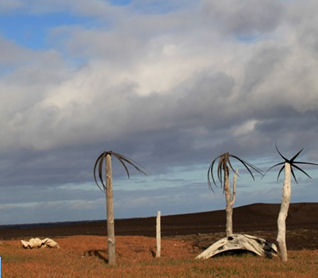 Whale bone and baleen palm trees at Barrow, Alaska |
September 8th – Barrow, Alaska
We arrived here in Barrow, AK September 4th and have spent the past few days catching up on email, picking up a part that was shipped to us (and again, a very special thanks to Judge Karen Hegyi for allowing us to have it shipped to her office), restocking the fridge and walking around town learning as much about it as we could. With its dirt streets, Barrow is an amazingly self-contained town which at first glance seems rough and tumble but on further investigation offers up just about everything towns twice its size would. A fully stocked supermarket is just up the road from a well known commercial bank, The Barrow Arctic Science Consortium can be found on the edge of town, and yes, the even world renowned “Pepe’s North of The Border” Mexican restaurant is here as well.
Amazed at Inuit Whaling
Yesterday Chaunce, Sefton and I went out to film Point Barrow which was quite an eye opener to say the least. I’m sure I’ll get some facts wrong as well as inadvertently offend someone but will tell you what we came across nonetheless. From August 15 to October 31, Alaskan Natives still engage in what’s referred to as “subsistence whaling” here in the Beaufort Sea. In fact when we were about thirty miles north of Barrow, we were warned-out of the area over the VHF radio. It seems there was a possibility of our interfering with the hunting of the Bowhead whales; it was felt that our engine noise would scare the whales off.
The hunting of the whales is not only a time-honored but a culturally honored event which, when we got out to Point Barrow, we were reminded of all too readily. We had been told that the Point was a bit of a whale burying-ground as that is where the whales, once killed, are brought ashore with small boats. It’s here that they are cut up and dispersed. I have to say I didn’t know what to expect until I got there and once there was stopped in my tracks by what I saw.
‘Dem Bones
As promised the area was strewn with an incredible amount of whale bone in every shape and form, yet not the clean, antiseptic, bleached-out bone that I semi-expected, but the relatively, freshly-stripped carcasses which, by this time, were going through the long processes of becoming that which I did expect.
To be perfectly blunt, it was not a pleasant sight nor smell. The bones, many still with sinew and fat on them, were dark with decay. I have to admit that for the first ten or fifteen minutes I was pretty much taken aback at what lay in front of me and in the air around me, equating it with that of nothing more than left-to-rot, road kill.
The Passing of a Human Culture
Slowly though, this dismay started to turn and I soon began to realize how foolish if not culturally chauvinistic I was being. All around me was not the litter of rot but in fact was one of the more tangible examples of a cultural act which has been time-honored and rightly respected for untold years. Granted, from my vantage point it was not a pretty sight, but from the vantage point of a person whose ancestors have been hunting and feeding themselves in this manner since time immemorial it is a way of life which rightly should know no judgment.
As with just about all the meat taken from the whale, the bones too get put to hundreds of uses; whalebone sod houses, whalebone art, baleen baskets, even a baleen Palm Tree.
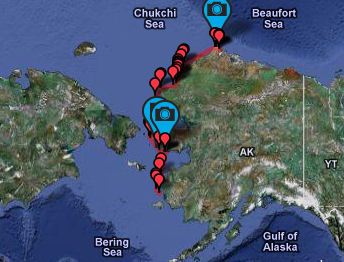 |
September 10th – Entering Bering Strait
Seeing a weather window on the wind charts we took full advantage of it, left Barrow the afternoon of the 7th and started in on our current leg to Dutch Harbor, via Nome. We’re now in “Delivery Mode”; no sightseeing, no trips to shore to film, no nuttin’ but hammer down. Due to their very shallow depths and strong weather patterns, the Chukchi and Bering Seas, where we are now, are notoriously unpredictable. Winds allowing, our aim is to scoot through them as quickly as possibly… winds allowing.
Anchoring Off
The next morning and in a building NE breeze, we anchored just off the coast in the lee of Kukpowruk Pass. The original thought was to enter and anchor in a small lagoon there but very quickly this proved unwise to attempt as the entrance was sided by heavy breakers suggesting a shallow bar and what opening we could find was about 8 feet deep. Discretion hopefully being the better part of valor we chose not to enter but anchor off instead. The swell from the NW was still in evidence so we all grabbed a full if not bumpy ten hours of rest.
25 knots+ and 8’ Seas
Around 4:00 p.m. we downloaded more weather charts and saw that the next window had started to open a bit sooner than we expected, so we up anchored and once again got back on the road. Unfortunately our timing wasn’t exactly spot on as by the time we reached Cape Lisburne we were taking quite a pounding (but not a thrashing); 25 – 30kts of wind with 8 to 10 foot seas.
That lasted most the afternoon and through the night. By the time we rounded we were able to take full advantage of being in the lee of the land and with the dying breeze, left the swell behind.
Saw Russia from Their Boat
At approximately 3:00 a.m. this morning we entered the Bering Straight (passing by Big and Little Diomede Islands – I guess you could say we saw Russia from our boat – if you really wanted to.
We’ve also left the Arctic Circle which I’ve very mixed emotions about. (More on that in another blog) and have now officially left the Chuckchi and are motoring quickly towards Nome with a hoped for 4:00 p.m. arrival. Not much planned at Nome except to officially check into the U.S. as Barrow didn’t have a Customs Office.
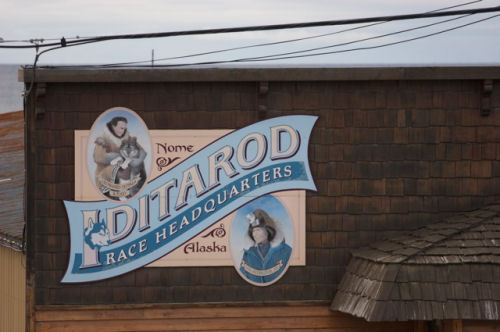 |
September 10th – Entering Bering Strait
September 14th – Nome, Alaska
We arrived here in Nome on the 10th and have been exploring ever since. This city of around 4,000 sits 102 miles below the Arctic Circle and the differences from where we’ve been are dramatic if not subtle. To take stock of where we were in the trip and what we still have to cover, yesterday I took an aimless sort of walk. I was quickly brought to the present by a remarkably unique scent.
I stopped to try and figure out what this powerful combination of sweet and acrid was when it dawned on me that I was smelling the simple scent of shrubbery and damp earth. We’d been above the Arctic Circle for so long that my nose had seemed to have forgotten the everyday scent of vegetation.
Gold Diggers and Dog Days
You don’t have to be here very long to realize that Nome has a rich and very strong history with gold. It was first discovered here in 1898 and the search for it today is as strong as ever. The inner basin of its harbor is filled with just about every conceivable size and design of dredging craft as people still search for gold on a daily basis. Talking to a local who is still on the hunt we were told that on a “good” day a person could dredge up around $8000 worth of the precious metal. I imagine the bad days speak for themselves.
But perhaps what Nome is most known for is the fact that it serves as the end of the Iditarod Trail Sled Dog Race. On the first Sunday of March a growing number of “mushers” and dog teams start what is known around the world as “The Last Great Race” from Anchorage and, 1049 miles later, end the race here in Nome. The race isn’t without its detractors but once you’ve seen how a pack of sled dogs react when they see their sled and harnesses you know that this marathon holds quite a wonderful and powerful emotional investment on every level.
Rubba Dub Dub
And then there’s the Bathtub Races. Occurring every Labor Day, bathtubs are outfitted with wheels and raced down Front Street. Some very stringent rules govern the race in that 1) Every tub must be full of water, 2) The “bather” must have a towel, bar of soap and a bath mat and 3) Tubs must have at least 10 gallons of water left in by the end of the race. Always wanting to improve things, I think that if they could combine the Iditarod with the Bathtub Races (dogs in the tubs being bathed) that the world would beat a path to Nome.
As always we’re keeping an eye on a weather window which we may try and take advantage of tomorrow, Sunday. Our next big event will be exiting the Bering Sea and entering the Pacific where we’ll head up to the east and eventually work our way down The Inside Passage, something I did years ago and am greatly looking forward to.
With this installment, BoatTEST.com will end its cyber-tracking of the yacht Bagan. We congratulate Sprague Theobald and his crew for their work and maritime success. Bagan’s passage certainly speaks well of the Nordhavn 57 and we hope that these installments will encourage other boaters to set their cruising horizons high.
